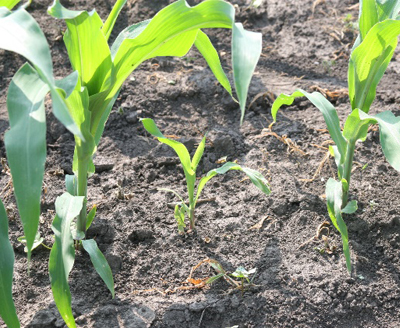
- Corn replant decisions can be complex, and many factors should be considered.
- Final plant population and uniformity of stand should be evaluated before making replant decisions.
- When using replanting tables, determine the yield potential based on original planting date and final stand, and compare to the replant yield potential.
- Factor in replant costs such as additional tillage, fuel, pesticides, labor, and seed.
- Remember to comply with crop insurance requirements and pesticide label restrictions.
Corn replant decisions can be complex, and many different factors should be considered prior to replanting. Modern crop production systems have multiple overlaid complexities, including stacked herbicide traits, insect defensive traits, in-furrow pesticides, supplemental seed treatments, and pre-emergence herbicides that can all factor into the replant decision. Below are the primary steps for approaching the corn replant challenge.
1. Evaluate Final Population. Take a minimum of 5 stand counts per field to determine if enough plants remain. Check stands in areas that differ in soil type, topography, and drainage. It’s possible that not all parts of the field will need to be replanted. Check the roots of smaller plants for any injury to the primary root system or damage to the endosperm, as such injury may not allow for complete recovery.
2. Evaluate Stand Uniformity. Unevenness due to gaps in the stand can reduce yield. Iowa State University guidelines suggest that recurrent gaps of 1 to 3 feet in length will reduce yield by 2%. Recurrent gaps of 4 to 6 feet in length will reduce yield by 5%. These reductions will occur even if the final plant population is adequate. Unevenness due to delayed emergence can also reduce yield potential between 4% and 25%, depending upon the percent of plants emerging late and the number of days delayed (Figure 1).
3. Determine Yield Potential. Refer to Table 1 to determine the percent of maximum yield potential for the original crop, based on planting date and final population. For example, if the final population of the field is 25,000 plants per acre for a planting date of April 20, the field should have 95% of maximum yield potential. Suppose the field has recurrent gaps of 1 to 3 feet and 25% of the field was delayed in emergence by 10 days, we would subtract another 2% and 6%, respectively. Now our estimated yield potential of the original stand is 87% of maximum.
4. Estimate the Replant Yield Potential. Continuing our example above, if the field can be replanted by May 25 and an optimum stand of 35,000 plants is achieved, the replant yield potential is also 87% of maximum. Bear in mind that replanting is no guarantee of adequate stand the second time around. In the case above, a farmer might be better off to take their odds with the first stand rather than accept the risks of replanting
5. Additional Considerations. Assuming that a replant can happen timely enough to generate an acceptable level of yield potential versus the optimum, revenue gains from that additional yield need to be weighed against the added costs of replanting and any expected offset from crop insurance. Costs to be considered include tillage, seed, fuel, pesticides, and labor. Several articles have addressed herbicide considerations when replanting. Some of the key things to consider are reduced efficacy with previously applied herbicides, total applied active ingredient restrictions per label, and herbicide tolerance traits in the second hybrid that can result in injury from any previously applied herbicides. Fields with corn rootworm, wireworm or white grub pressure may require a second application of soil insecticide or insecticide seed treatment. Insecticides applied in-furrow and at planting have total active ingredient restrictions per growing season. Whether additional pesticides can be applied will depend on the original application rate and the label restrictions. Bottom line on any pesticide is to always read and follow the label directions. Additionally, later planting carries risk for delayed harvest and early frost, so replant hybrid selection may need to lean toward earlier maturities. Later planting is also associated with increased disease and insect pressure, so replant hybrids may need to carry more aggressive defensive traits. Additional costs can be expected for downstream fungicide and insecticide applications to combat these threats.
6. Replanting. If the decision is to replant, consider destroying the existing stand with tillage or herbicide, rather than inter-planting. Be cognizant of herbicide label plant back restrictions if using chemical means to control the prior stand of corn. Planting into well-established corn plants is like planting into an existing stand of weeds. The older, well-established corn plants will successfully compete for light, water, and nutrients. Yield of the new stand that is planted into an existing stand of corn will likely be disappointing. If areas to be replanted are somewhat small and scattered or localized over drainage patterns, inter-planting may be the only option to increase harvest stand.
Uneven Stand Yield Loss Calculator (Iowa State University)
Replant Checklist (Iowa State University)
Corn Replant Decision Making (Purdue University)
Figures and Tables

Figure 1. Delayed Emergence Impact on Yield. (Source: Iowa State University)

Table 1. Impact of final population and planting on corn yield. (Source: Iowa State University).